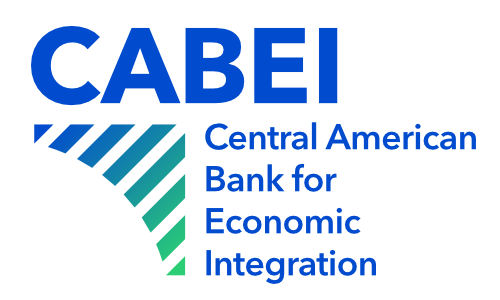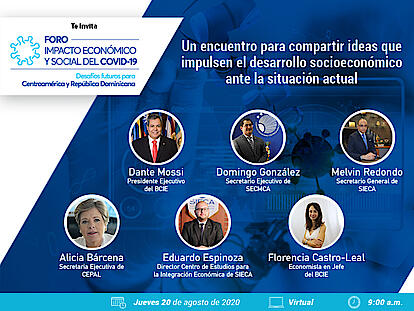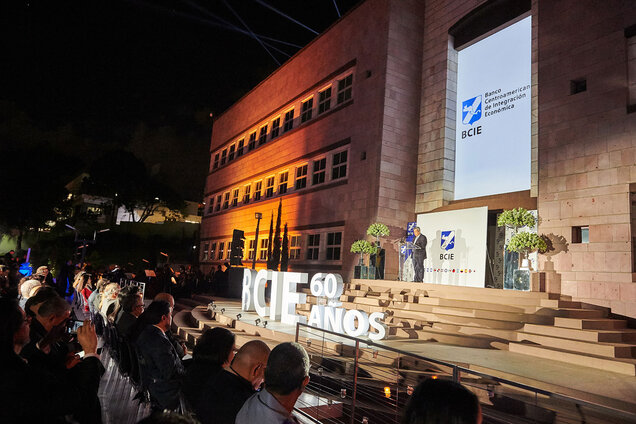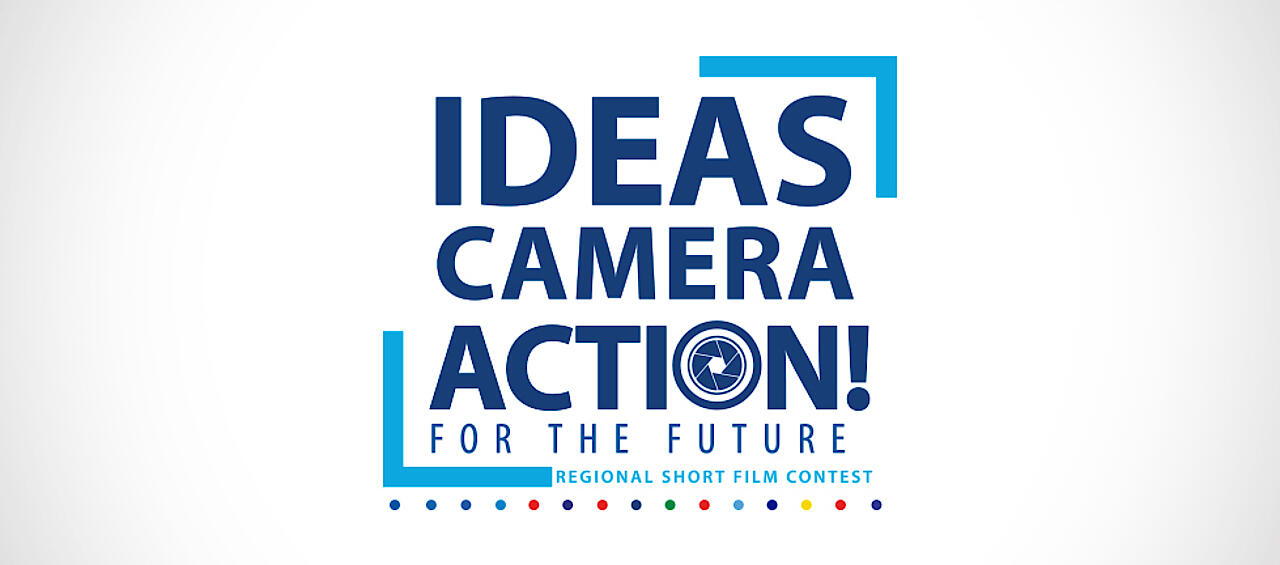63 years promoting
the development of the region
Throughout 61 years, the Central American Bank for Economic Integration (CABEI) has supported the economic growth and social welfare of the region as its main multilateral resource provider.
Events
Forum
Science, Technology and Innovation for Development: The New Normality
Filmmaking Contest
"Ideas, Camera, Action for the future"
Board of Governors
LX Annual Meeting of the Board of Governors
Webinar
Opportunities and Challenges to Promote the Use of Natural Gas in SICA countries
Forum
Social and Economic Impact of COVID-19
Milestones
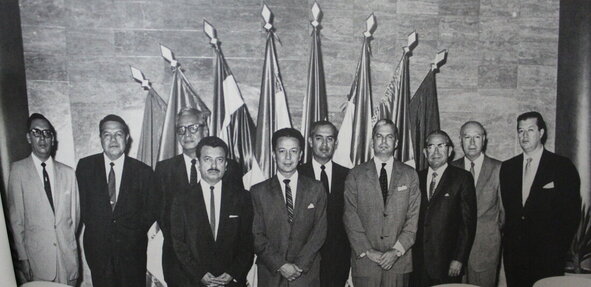
Executive President and CABEI Directors at the inauguration of the Bank
1960 - The General Central American Integration Treaty is signed, thereby creating CABEI.
1961- Inauguration and start of CABEI activities, Tegucigalpa, May 31 and June 1, 1961.
1962- Accession of Costa Rica to the General Central American Integration Treaty through which CABEI is created. San José, Costa Rica, July 1962.
1963- Accession of Costa Rica to the Constitutive Agreement of the Central American Bank for Economic Integration, San José, Costa Rica, July 1963.
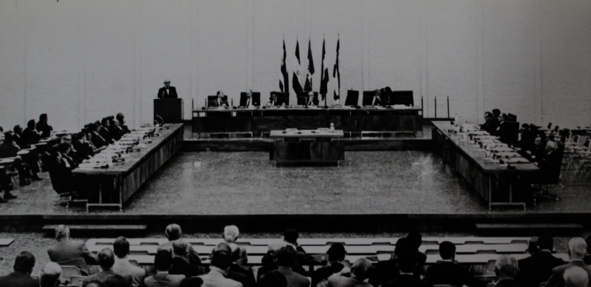
General Assembly of Governors in Buenos Aires, Argentina
1973- CABEI makes the first private placement of bonds for $10 million.
1972-1976- CABEI responds to natural disasters that occurred in Nicaragua, Honduras and Guatemala.
1978-1979- Financing of the programs: Regional Highway Network and the Regional Telecommunications Artery, which absorbed $CA 700.2 million, and led the construction and improvement of more than 3,200 km of highway.
The efforts made by the countries to face the problems represented by the energy crisis led CABEI to finance hydroelectric projects amounting to $CA 197.6 million, contributing to the development of important projects such as Chixoy and Aguacapa-Moyuta in Guatemala and El Cajon in Honduras.
1978- Bank Board of Governors authorizes capital increase from $60 to $200 million.
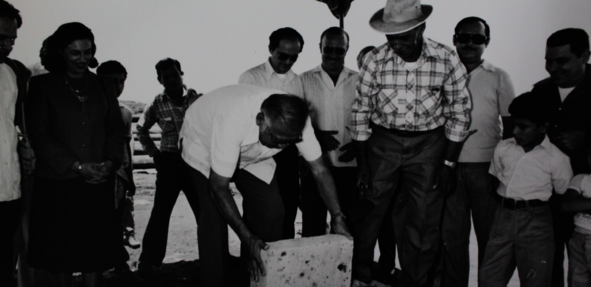
CABEI places first stone for its Headquarters
1982- Protocol to the CABEI Constitutive Agreement, Managua, October 14.
1989- A preliminary draft of the protocol of reforms to the Constitutive Agreement is approved, including the necessary amendments for the incorporation of extra-regional members into the institution.
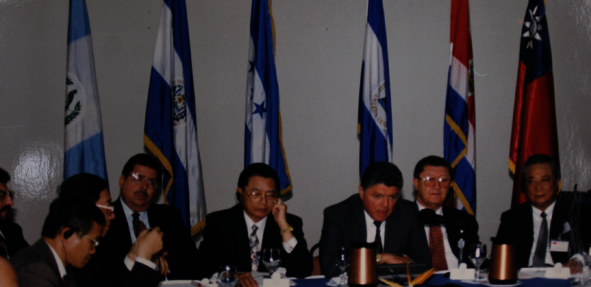
Visit from investors from the Republic of China (Taiwan)
1992- CABEI's authorized capital is increased from US$600 million to US$2.00 billion.
1992- The CABEI constitutive agreement reforms approved in 1989 that allow the incorporation of extra-regional members enter into force and the Republic of China (Taiwan) and Mexico join the Bank. July 14 and 29.
1995- CABEI's first indicative rating (shadow rating) of “B” is obtained.
1995- Argentina joins CABEI.
1997- CABEI issues its first green bond in the Republic of China (Taiwan).
1997- Colombia joins CABEI.
1998- Changes to the constitutive agreement are approved, establishing that the Institution's Executive President must be elected through an international contest mechanism based on technical criteria.
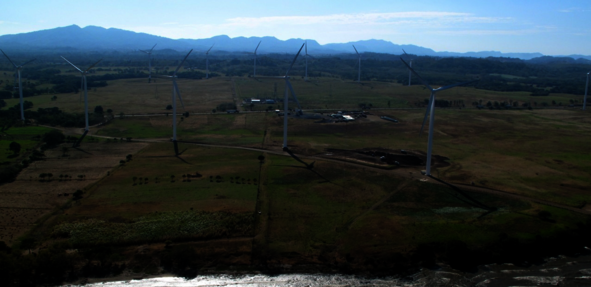
Eolico Amayo Wind Farm Project financed by CABEI in Nicaragua
2000- CABEI obtains the first credit rating equivalent to an investment grade awarded by the National Association of Insurance Commissioners (NAIC).
2001- President of Spain announces the decision to join CABEI as an extra-regional member.
2002- CABEI obtains the first investment grade ratings granted by international rating agencies in the BBB range.
2004- Financing for the debt relief quota for Honduras and Nicaragua is successfully completed (HIPIC initiative).
2004- The 2004 - 2009 Institutional Strategy is launched.
2005- CABEI obtains first credit rating in the A range, issued by the Moody´s rating agency
2005- Spain joins CABEI as the first European extra-regional member.
2006- Belize joins CABEI.
2006- CABEI partially finances the Central American Electric Interconnection System (SIEPAC) with an initial loan of US$40 million, followed by a second loan of US$4.5 million.
2006- CABEI begins to finance the Las Pailas Geothermal Project (Costa Rica) for US$160.0 million. The plant has an installed capacity of 35 MW with an average annual generation of 272.9 GWh.
2007- Panama and the Dominican Republic join CABEI.
2007- CABEI obtains A- credit ratings from Fitch Ratings and Standard & Poor´s.
2008- International financial crisis impacts economies worldwide, while CABEI maintains its solid financial position and uninterrupted financing towards the region.
2009- Approval of the Bank's authorized capital increase from US$2.00 billion to US$5.00 billion.
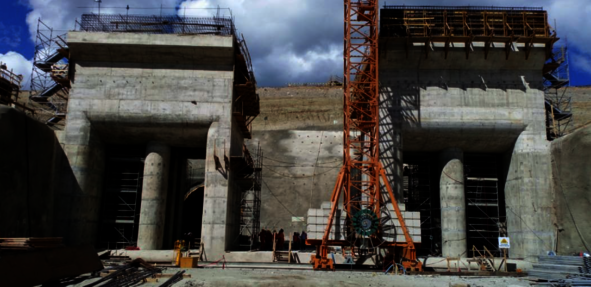
Visit to Monte Grande Dam Project in Dominican Republic
2010- CABEI's 2010-2014 institutional strategy, "Competitiveness with Integration and Social Development," is launched.
2010- The development impact measurement framework is implemented through the Development Impact Index (I-CABEI).
2015- The CABEI 2015 - 2019 institutional strategy, "Integrating Sustainable Development and Competitiveness,” is launched.
2015- Approval of reforms to the CABEI constitutive agreement that allow equal treatment for all full member members of SICA.
2015- CABEI is accredited as a Regional Implementing Entity by the Adaptation Fund. The accreditation will provide access to resources for the execution of programs and projects that contribute to preventing and mitigating the effects of climate change in the countries of the region.
2016- CABEI is accredited by the Green Climate Fund (GCF). The accreditation, which enables the Bank to carry out large-scale projects (the highest category of the GCF: greater than US$250.0 million), also gives it access to all the current financial instruments of the Fund, including loans, donations, equity holdings and partial guarantees with the highest environmental and social category (A), as well as financing to carry out micro, small, medium and large projects.
2016- CABEI is accredited as a Permanent Observer to the United Nations Framework Convention on Climate Change (UNFCCC).
2017- Board of Governors approves the entry of the Republic of Cuba as an extra-regional member.
2017- Fitch Ratings Rating Agency improves CABEI's business profile to A +.
2018- Cuba joins CABEI.
2018- The Republic of Korea officially requests its incorporation as an extra-regional member.
2018- Approval of CABEI capital increase from US$5.00 billion to US$7.00 billion.
2019- CABEI presents the Trinational Master Economic Development Investment Plan for the Gulf of Fonseca. An instrument of planning, negotiation and coordination between the countries in the short, medium and long term for the development of this area.
2019- CABEI issues its Zero Carbon Initiative declaration.
2019- CABEI issues statement on Access to Information initiative.
2019- CABEI is consolidated as the best risk throughout Latin America by receiving an upgrade in Moody’s Investors Service rating from “A1” to “Aa3.”
2019- Standard & Poor’s confirms the risk rating at “AA.”
2019- CABEI issues its first global green bond, making resources available to its members to finance or refinance eligible projects and green assets under the CABEI Green Bond Framework, supporting strategic sectors with significant contributions to Central America's transition to low carbon economies, including sustainable land use, renewable energy, sustainable water management and clean transportation, among others.
2019- CABEI approves US$550.0 million for the rapid passenger train of the Greater Metropolitan Area of Costa Rica, which will allow such benefits as better transportation times and less expenses for inhabitants and the country; improvements in health and air quality; and a reduction in the country's carbon emissions with the aim of decarbonizing the economy.
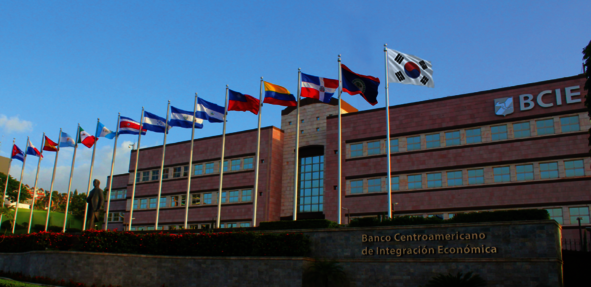
CABEI Heaquarters in Tegucigalpa, Honduras
2020- Korea concludes all formal incorporation requirements.
2020- In response to the COVID-19 global pandemic, CABEI launches the Emergency Support and Preparedness Program for COVID-19 and economic reactivation.
The Program responds to the efforts for the prevention and containment of the health emergency faced by the member countries of the Bank. In addition to implementing short and medium-term actions with the aim of strengthening the regional economy.
